#DriverlessEd aims to teach consumers about autonomous vehicles (AVs), everything from the driverless technology that powers them, to the rigorous safety practices and the rider experience.
Be sure to explore the previous five chapters:
Chapter 1: Why Driverless Vehicles?
Chapter 2: The Difference Between AVs and ADAS
So what’s it like actually riding in a vehicle with no driver behind the wheel?
While you’ll be riding in one of the most advanced pieces of technology in the world, ideally, it will feel as easy as riding in any other ride-hail vehicle (except safer).
“You won’t need a degree in robotics or computer science to ride in a robotaxi,” said Andrea Nelson, Motional’s Vice President of Product. “The whole process – from hailing a robotaxi and getting in the vehicle, to getting questions answered and ending the ride – will feel intuitive, even if it's the first time that person is trying a robotaxi.”
AV companies like Motional don’t want riding in a robotaxi to bring up memories of eternal struggles learning new high-tech gadgets, such as fixing the time on a VCR, or teaching a grandparent the newest smartphone app. Instead, Motional has been studying all the little steps we take – sometimes unconsciously – as passengers during a trip in a ride-hail vehicle and developing tech-based substitutes.
“If we have to ask longtime ride-hail passengers to learn a whole new set of customs and processes just to use a robotaxi, wide-scale adoption will take that much longer,” said Akshay Jaising, Motional’s Vice President of Commercialization. “No matter how many new features robotaxis offer passengers, ease of use will remain one of the most important factors.”
Motional wants riders to walk away from their ride with three main thoughts, according to Jaising; that the ride was safe, the ride was comfortable, and they want to ride in a robotaxi again soon.
This chapter of DriverlessEd focuses on what it's like to ride in a robotaxi, the steps AV companies such as Motional have taken to replicate the roles and responsibilities currently performed by a human driver, and ways tech can be used to provide a better, more personalized, in-vehicle experience.

REPLACING THE HUMAN DRIVER
Human drivers have flaws -- about 800,000 crashes annually are caused by distracted drivers texting or using their phones behind the wheel. However, ride-hail drivers also play an important role in every trip.
Beyond actually controlling the vehicle’s movement, human drivers also verify that the passenger is getting in the correct vehicle, they unlock the vehicle, ensure the passenger is seated and buckled before starting the drive, answer questions the passenger has, change routes if needed, let the passenger know when they’ve arrived at their destination, and check the vehicle for any items left behind.
These aren’t optional steps that can be skipped just because the vehicle is driverless. A robotaxi that takes off before the passenger has closed the door and put on their seatbelt is neither operating safely nor comfortably. Passengers will sometimes have questions or need to change their destination and require a way to communicate that. If they’re unable to do so, they may not want to take a robotaxi again.
“Our product teams have spent considerable time studying each step of a ride-hail trip, including every verbal touch point between the driver and passenger, and every physical action a passenger needs to take, in order to make sure that same rhythm is reflected when there is no driver in the driver’s seat,” said Nelson.
The goal is to make the driverless process seem familiar, even for first time passengers – like they instinctively know what to do based on previous experiences with human-driven ride-hails or taxis.
Interested in taking a ride in a Motional IONIQ 5 robotaxi? Click to learn more!
JUST SWIPE TO GO
Motional passengers can track their vehicles as they approach, just as they currently do with human-driven ride-hails. When the robotaxi pulls up to the designated pickup spot, the passenger can unlock the vehicle’s doors through the ride-share app. (If a passenger does not have access to the app – maybe someone ordered the ride for them, or their device ran out of power – they will be able to press a service button on the door and speak to a remote agent). Even if multiple robotaxis pull up to the same pick up spot, the passenger will only be able to unlock the doors for their designated vehicle.
The robotaxi will know how many people have gotten in the vehicle, whether the doors are still open, and if all riders have put on their seatbelts. The rider can then start the ride by touching a button on their smartphone app or on a touchscreen device attached to the back of the seats.
Passengers will be able to follow along the ride route using in-vehicle screens. If a passenger needs to add a stop or change their destination – perhaps they’re asked to pick up something at the pharmacy on their way home, or meet friends at a different restaurant – they’ll be able to make that request using the in-vehicle screens.
Upon arriving at the destination, the vehicle will let the passenger know via its screen and an audio cue that the trip is over and it's safe to exit. In-cabin sensors will be able to detect if someone didn’t exit the vehicle or even if the passenger left something behind.

A HUMAN TOUCH
This doesn’t mean that a robotaxi passenger is isolated during the ride. In fact the vehicles are connected to multiple support teams ready to assist if there’s a question or problem.
Command center
Every robotaxi is outfitted with GPS so the local operations center knows where every vehicle in the fleet is at every moment. Every vehicle also has its own unique tracking screen that allows human techs to know if the robotaxi currently has a passenger inside, and where it's going. The screen also monitors vehicle health, such as remaining battery power, tire air pressure, and the status of all of the vehicle’s sensors. If a problem does arise, it can then call the vehicle back to the garage.
Remote Customer Assistance
Motional understands that sometimes ride-hail passengers have questions or may even have an emergency. If so, passengers will be able to press a button inside the vehicle and be connected immediately to a person. Perhaps the passenger has a question about why the vehicle reacted a certain way, or needs to end the ride unexpectedly – customer assistance is just a push of a button away.
Remote Vehicle Assistance
Every driver has come across a situation they weren’t immediately sure how to handle. Robotaxis likewise can handle nearly every driving situation they encounter. But if the robotaxi finds itself in an unusual situation, the vehicle will stop and contact Remote Vehicle Assistance. A human won’t manually take over the vehicle; rather it will help the vehicle decide on a new, safe path forward. The whole process should feel seamless to the rider.

A PERSONAL EXPERIENCE
In some ways, a robotaxi is a blank canvas. The vehicle is part of a larger fleet; it's not someone’s personal vehicle. And it’s a vehicle layered with high-performing technology, including an extra computer system in the rear. That means it can be personalized for passengers in ways never before possible for a taxi or hide-hail vehicle.
For example, before the vehicle even arrives, the passenger is able to adjust the climate control so that the cabin temperature is just right. In the future, vehicles will be able to support a selection of pre-set customer settings that adjust vehicle music, interior lighting, even driving style.
“Passengers will be able to see robotaxis as an extension of their personal space,” said Jaising. “They will have an unprecedented ability to control their ride experience making it more enjoyable to travel.”
Vehicles that drive autonomously require some of the most advanced technology in the world. But riding in a robotaxi shouldn’t feel like a trip in a piece of technology.
Passengers in a Motional robotaxi will notice how similar it feels to riding in a human-driven vehicle. Just safer. And maybe with better music.

